Phoenicia
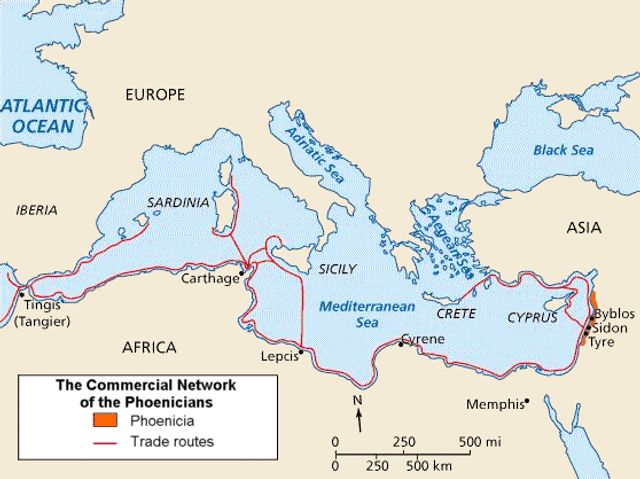
Phoenicia

| 2500 BC[1]–539 BC | |
| Capital | Byblos(2500–1000 BC)Tyre(900–550 BC)[2] |
|---|---|
| Common languages | Phoenician,Punic |
| Religion | Canaanite religion |
| Government | City-statesruled bykings |
| Well-known kings of Phoenician cities | |
| Ahiram | |
| Hiram I | |
| Pygmalion of Tyre | |
| Historical era | Classical antiquity |
| 2500 BC[1] | |
| 969 BC | |
| 814 BC | |
| 539 BC | |
| Area | |
| 1000 BC | 20,000 km (7,700 sq mi) |
Phoenicia (/fəˈnɪʃə/;[3] from Ancient Greek: Φοινίκη, Phoiníkē) was a thalassocratic, ancient Semitic-speaking Mediterranean civilization that originated in the Levant, specifically Lebanon, in the west of the Fertile Crescent. Scholars generally agree that it was centered on the coastal areas of modern day Lebanon and included parts of what are now northern Israel and southern Syria reaching as far north as Arwad, but there is some dispute as to how far south it went, the furthest suggested area being Ashkelon.[4] Its colonies later reached the Western Mediterranean, such as Carthage in North Africa, and even the Atlantic Ocean, such as Cádiz in Spain. The civilization spread across the Mediterranean between 1500 BC and 300 BC.
Phoenicia is an ancient Greek term used to refer to the major export of the region, cloth dyed Tyrian purple from the Murex mollusc, and referred to the major Canaanite port towns; not corresponding precisely to Phoenician culture as a whole as it would have been understood natively. Their civilization was organized in city-states, similar to those of ancient Greece,[5], centered in modern Lebanon, of which the most notable cities were Tyre, Sidon, Arwad, Berytus, Byblos, and Carthage.[6] Each city-state was a politically independent unit, and it is uncertain to what extent the Phoenicians viewed themselves as a single nationality. In terms of archaeology, language, lifestyle, and religion there was little to set the Phoenicians apart as markedly different from other residents of the Levant.[7]
Around 1050 BC, a Phoenician alphabet was used for the writing of Phoenician.[8] It became one of the most widely used writing systems, spread by Phoenician merchants across the Mediterranean world, where it evolved and was assimilated by many other cultures, including the Roman alphabet used by Western civilization today.[9]
| 2500 BC[1]–539 BC | |
| Capital | Byblos(2500–1000 BC)Tyre(900–550 BC)[2] |
|---|---|
| Common languages | Phoenician,Punic |
| Religion | Canaanite religion |
| Government | City-statesruled bykings |
| Well-known kings of Phoenician cities | |
| Ahiram | |
| Hiram I | |
| Pygmalion of Tyre | |
| Historical era | Classical antiquity |
| 2500 BC[1] | |
| 969 BC | |
| 814 BC | |
| 539 BC | |
| Area | |
| 1000 BC | 20,000 km (7,700 sq mi) |
Etymology
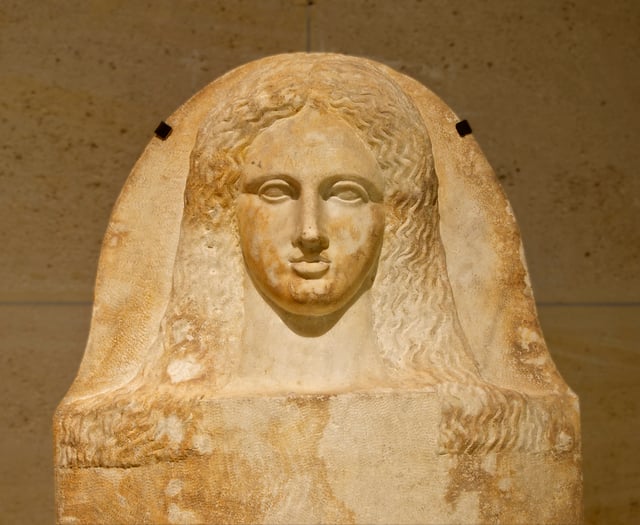
Cover of a Phoenician anthropoid sarcophagus of a woman, made of marble, 350–325 BC, from Sidon, now in the Louvre.
The name Phoenicians, like Latin Poenī (adj. poenicus, later pūnicus), comes from Greek Φοίνικες (Phoínikes). The word φοῖνιξ phoînix meant variably "Phoenician person", "Tyrian purple, crimson" or "date palm" and is attested with all three meanings already in Homer.[10] (The mythical bird phoenix also carries the same name, but this meaning is not attested until centuries later.) The word may be derived from φοινός phoinós "blood-red",[11]*Webster's%20Third%20New%20Int]]*Webster's%20Third%20New%20Int]]*Webster's%20Third%20New%20Int]]*Webster's%20Third%20New%20Int]]*Webster's%20Third%20New%20Int]]Webster's%20Third%20New%20Int]]Webster's%20Third%20New%20Int]]itself possibly related to φόνος phónos "murder".
It is difficult to ascertain which meaning came first, but it is understandable how Greeks may have associated the crimson or purple color of dates and dye with the merchants who traded both products.
Robert S. P. Beekes has suggested a pre-Greek origin of the ethnonym.[12]*Etymological%20Dictionary%20of%20G]]*ycenaean]][15]*Entre%20la%20Bible%20et%20l'Histoir]]*Entre%20la%20Bible%20et%20l'Histoir]]*Entre%20la%20Bible%20et%20l'Histoir]]*Entre%20la%20Bible%20et%20l'Histoir]]Entre%20la%20Bible%20et%20l'Histoir]]
The land was natively known as 𐤐𐤕 (Pūt) and its people as the 𐤐𐤍𐤉𐤌 (Pōnnim).[17] In the Amarna letters of the 14th century BC, people from the region called themselves Kenaani or Kinaani, equivalent to Canaanite. The common Canaanite identity was gradually differentiated into regional subgroups, of which the Phoenicians were one, so they continued to use Canaanite as one of their self-designations.[17] Thus, much later, in the sixth century BC, Hecataeus of Miletus writes that Phoenicia was formerly called χνα khna, a name that Philo of Byblos later adopted into his mythology as his eponym for the Phoenicians: "Khna who was afterwards called Phoinix".[18] The ethnonym survived in North Africa until the fourth century AD (see Punic language). As late as the 3rd century, as mentioned by Augustine of Hippo, an African identified himself as Chanani.[17] Conversely, the names of the inhabitants of most prominent Phoenician cities Tyre and Sidon could sometimes also be used to refer to Phoenicians in general, so that for instance the self-designation Sorim, Tyrians, was used in Tripolitania.[17]
History
Origins
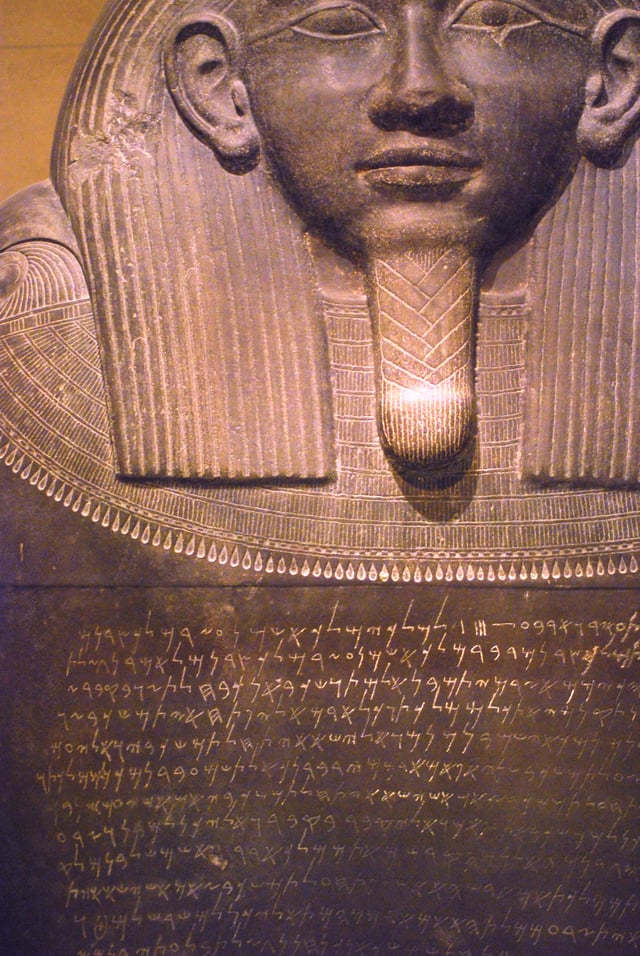
Sarcophagus of Eshmunazor II (5th century BC), Phoenician king of Sidon found near Sidon, in southern Lebanon
Herodotus's account (written c. 440 BC) refers to the myths of Io and Europa.
According to the Persians best informed in history, the Phoenicians began the quarrel. These people, who had formerly dwelt on the shores of the Erythraean Sea, having migrated to the Mediterranean and settled in the parts which they now inhabit, began at once, they say, to adventure on long voyages, freighting their vessels with the wares of Egypt and Assyria...— Herodotus, The History, I.1 [164]
The Greek historian Strabo believed that the Phoenicians originated from Bahrain.[19] Herodotus also believed that the homeland of the Phoenicians was Bahrain.[20][21] This theory was accepted by the 19th-century German classicist Arnold Heeren who said that: "In the Greek geographers, for instance, we read of two islands, named Tyrus or Tylos, and Aradus, which boasted that they were the mother country of the Phoenicians, and exhibited relics of Phoenician temples."[22] The people of Tyre in South Lebanon in particular have long maintained Persian Gulf origins, and the similarity in the words "Tylos" and "Tyre" has been commented upon.[23] The Dilmun civilization thrived in Bahrain during the period 2200–1600 BC, as shown by excavations of settlements and Dilmun burial mounds. However, some claim there is little evidence of occupation at all in Bahrain during the time when such migration had supposedly taken place.[24]
Canaanite culture apparently developed in situ from the earlier Ghassulian chalcolithic culture. Ghassulian itself developed from the Circum-Arabian Nomadic Pastoral Complex, which in turn developed from a fusion of their ancestral Natufian and Harifian cultures with Pre-Pottery Neolithic B (PPNB) farming cultures, practicing the domestication of animals, during the 6200 BC climatic crisis which led to the Neolithic Revolution in the Levant.[25] Byblos is attested as an archaeological site from the Early Bronze Age. The Late Bronze Age state of Ugarit is considered quintessentially Canaanite archaeologically,[26] even though the Ugaritic language does not belong to the Canaanite languages proper.[27][28]
Phoenician alphabet
The Canaanite-Phoenician alphabet consists of 22 letters, all consonants.[9] Starting around 1050 BC,[28] this script was used for the writing of Phoenician, a Northern Semitic language. It is believed to be one of the ancestors of modern alphabets.[29][30] By their maritime trade, the Phoenicians spread the use of the alphabet to Anatolia, North Africa, and Europe, where it was adopted by the Greeks who developed it into an alphabetic script to have distinct letters for vowels as well as consonants.[31][32]
The name "Phoenician" is by convention given to inscriptions beginning around 1050 BC, because Phoenician, Hebrew, and other Canaanite dialects were largely indistinguishable before that time.[28][8] The so-called Ahiram epitaph, engraved on the sarcophagus of king Ahiram from about 1000 BC shows essentially a fully developed Phoenician script.[33][34][35]
The Phoenicians were among the first state-level societies to make extensive use of alphabets: the family of Canaanite languages, spoken by Israelites, Phoenicians, Amorites, Ammonites, Moabites and Edomites, was the first historically attested group of languages to use an alphabet, derived from the Proto-Canaanite script, to record their writings. The Proto-Canaanite script uses around 30 symbols but was not widely used until the rise of new Semitic kingdoms in the 13th and 12th centuries BC.[36] The Proto-Canaanite script is derived from Egyptian hieroglyphs.[37]
High point: 1200–800 BC
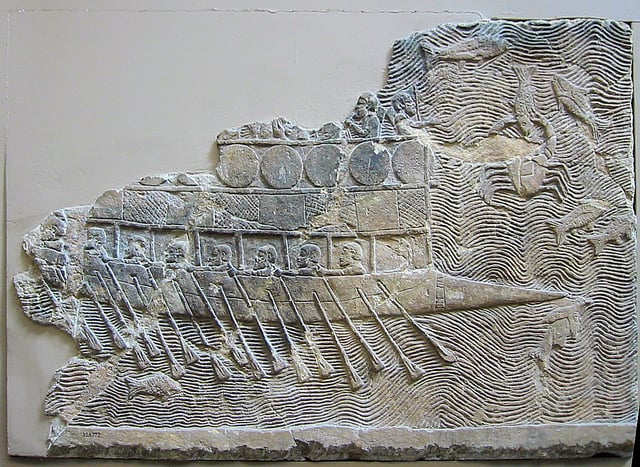
Assyrian warship (probably built by Phoenicians) with two rows of oars, relief from Nineveh, c. 700 BC.
Fernand Braudel remarked in The Perspective of the World that Phoenicia was an early example of a "world-economy" surrounded by empires. The high point of Phoenician culture and sea power is usually placed c. 1200–800 BC. Archaeological evidence consistent with this understanding has been difficult to identify. A unique concentration in Phoenicia of silver hoards dated between 1200 and 800 BC, however, contains hacksilver with lead isotope ratios matching ores in Sardinia and Spain.[38] This metallic evidence agrees with the biblical attestation of a western Mediterranean Tarshish said to have supplied King Solomon of Israel with silver via Phoenicia, during the latter's heyday (see 'trade', below).[39]
Many of the most important Phoenician settlements had been established long before this: Byblos, Tyre in South Lebanon, Sidon, Simyra, Arwad, and Berytus, the capital of Lebanon, all appear in the Amarna tablets.
The league of independent city-state ports, with others on the islands and along other coasts of the Mediterranean Sea, was ideally suited for trade between the Levant area, rich in natural resources, and the rest of the ancient world. Around 1200 BC, a series of poorly-understood events weakened and destroyed the adjacent Egyptian and Hittite empires. In the resulting power vacuum, a number of Phoenician cities rose as significant maritime powers.
Phoenician societies rested on three power-bases: the king; temples and their priests; and councils of elders.
Byblos first became the predominant center from where the Phoenicians dominated the Mediterranean and Erythraean (Red) Sea routes. It was here that the first inscription in the Phoenician alphabet was found, on the sarcophagus of Ahiram (c. 1200 BC).
Later, Tyre in South Lebanon gained in power. One of its kings, the priest Ithobaal (887–856 BC), ruled Phoenicia as far north as Beirut, and part of Cyprus. Carthage was founded in 814 BC under Pygmalion of Tyre (820–774 BC). The collection of city-states constituting Phoenicia came to be characterized by outsiders and the Phoenicians as Sidonia or Tyria. Phoenicians and Canaanites alike were called Sidonians or Tyrians, as one Phoenician city came to prominence after another.
Decline: 539–65 BC
Persian rule
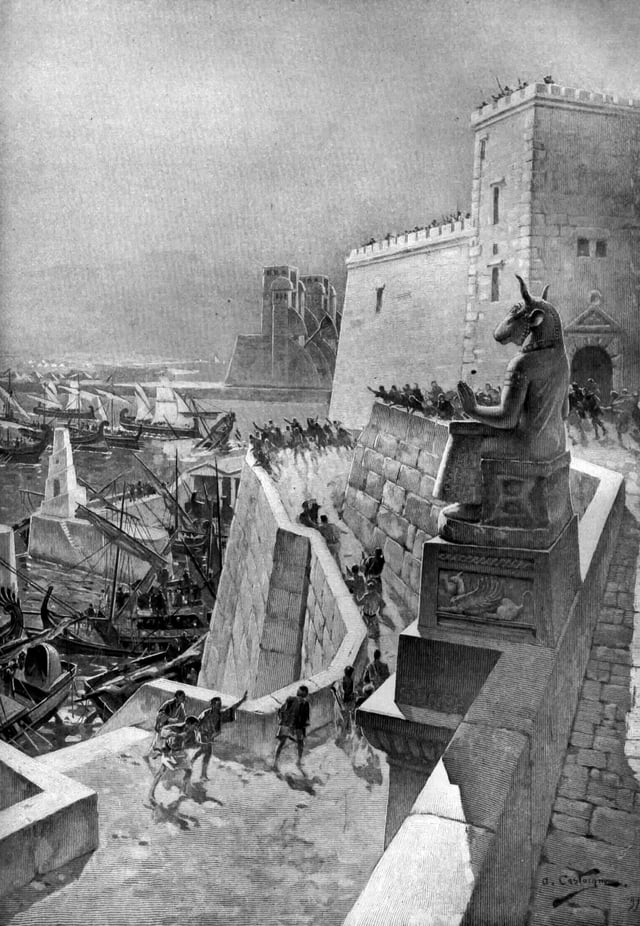
A naval action during the siege of Tyre in South Lebanon (350 BC). Drawing by André Castaigne
Persian King Cyrus the Great conquered Phoenicia in 539 BC. The Persians then divided Phoenicia into four vassal kingdoms: Sidon, Tyre, Arwad, and Byblos. They prospered, furnishing fleets for Persian kings. Phoenician influence declined after this. In 350 or 345 BC, a rebellion in Sidon led by Tennes was crushed by Artaxerxes III. Its destruction was described by Diodorus Siculus.
Macedonian rule
Alexander the Great took Tyre in 332 BC after the Siege of Tyre. Alexander was exceptionally harsh to Tyre, crucifying 2,000 of the leading citizens, but he maintained the king in power.[40] He gained control of the other cities peacefully: the ruler of Aradus submitted; the king of Sidon was overthrown. Following Alexander, the Phoenician homeland was controlled by a succession of Macedonian rulers: Laomedon (323 BC), Ptolemy I (320), Antigonus II (315), Demetrius (301), and Seleucus (296). The rise of Macedon gradually ousted the remnants of Phoenicia's former dominance over the Eastern Mediterranean trade routes. Between 286 and 197 BC, Phoenicia (except for Aradus) fell to the Ptolemies of Egypt, who installed the high priests of Astarte as vassal rulers in Sidon (Eshmunazar I, Tabnit, Eshmunazar II).
In 197 BC, Phoenicia along with Syria reverted to the Seleucids. The region became increasingly Hellenized, although Tyre became autonomous in 126 BC, followed by Sidon in 111. While Phoenician culture disappeared entirely in the motherland, Carthage continued to flourish in Northwest Africa. It oversaw the mining of iron and precious metals from Iberia, and used its considerable naval power and mercenary armies to protect commercial interests, until Rome finally destroyed it in 146 BC at the end of the Punic Wars.
Syria, including Phoenicia, was seized and ruled by king Tigranes the Great of Armenia from 82 until 69 BC, when he was defeated by Lucullus. In 65 BC, Pompey finally incorporated the territory as part of the Roman province of Syria. Phoenicia became a separate province c. AD 200.
Demographics
Genetic studies
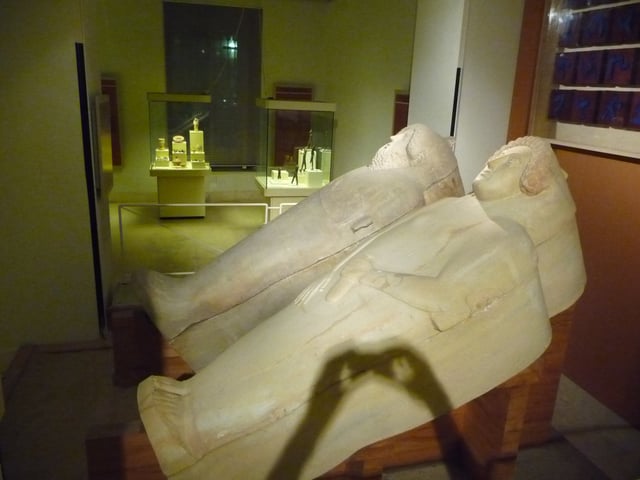
Phoenician sarcophagi found in Cádiz, now in the Archaeological Museum of Cádiz; the sarcophagi are thought to have been imported from the Phoenician homeland around Sidon.[41]
A study by Pierre Zalloua and others (2008) claimed that six subclades of haplogroup J2 (J-M172) J2 in particular, were "a Phoenician signature" amongst modern male populations tested in "the coastal Lebanese Phoenician Heartland and the broader area of the rest of the Levant (the "Phoenician Periphery")", followed by "Cyprus and South Turkey; then Crete; then Malta and East Sicily; then South Sardinia, Ibiza, and Southern Spain; and, finally, Coastal Tunisia and cities like Tingris [sic] in Morocco". (Samples from other areas with significant Phoenician settlements, in Libya and southern France could not be included.) This deliberately sequential sampling represented an attempt to develop a methodology that could link the documented historical expansion of a population, with a particular geographic genetic pattern or patterns. The researchers suggested that the proposed genetic signature stemmed from "a common source of related lineages rooted in Lebanon".[42]
None of the geographical communities tested, Zalloua pointed out subsequently (2013), carried significantly higher levels of the proposed "Phoenician signature" than the others.
This suggested that genetic variation preceded religious variation and divisions and, by the time it became Phoenicia, "Lebanon already had well-differentiated communities with their own genetic peculiarities, but not significant differences, and religions came as layers of paint on top." [43] Another study found evidence for genetic persistence on the island of Ibiza.[44]
In 2016, a sixth-century BC skeleton of a young Carthaginian man, excavated from a Punic tomb in Byrsa Hill, was found to belong to the rare U5b2c1 maternal haplogroup. The lineage of this "Young Man of Byrsa" is believed to represent early gene flow from Iberia to the Maghreb.[48]
Economy
Trade
The Phoenicians were among the greatest traders of their time and owed much of their prosperity to trade.
At first, they traded mainly with the Greeks, trading wood, slaves, glass and powdered Tyrian purple. Tyrian purple was a violet-purple dye used by the Greek elite to color garments. As trading and colonizing spread over the Mediterranean, Phoenicians and Greeks seemed to have split that sea in two: the Phoenicians sailed along and eventually dominated the southern shore, while the Greeks were active along the northern shores. The two cultures rarely clashed, mainly in the Sicilian Wars, and eventually settled into two spheres of influence, the Phoenician in the west and the Greek to the east.
In the centuries after 1200 BC, the Phoenicians were the major naval and trading power of the region.
Phoenician trade was founded on the Tyrian purple dye, a violet-purple dye derived from the hypobranchial gland of the Murex sea-snail, once profusely available in coastal waters of the eastern Mediterranean Sea but exploited to local extinction. James B. Pritchard's excavations at Sarepta in present-day Lebanon revealed crushed Murex shells and pottery containers stained with the dye that was being produced at the site. The Phoenicians established a second production center for the dye in Mogador, in present-day Morocco. Brilliant textiles were a part of Phoenician wealth, and Phoenician glass was another export ware.
To Egypt, where grapevines would not grow, the 8th-century Phoenicians sold wine: the wine trade with Egypt is vividly documented by the shipwrecks located in 1997 in the open sea 50 kilometres (30 mi) west of Ascalon.[49] Pottery kilns at Tyre in South Lebanon and Sarepta produced the large terracotta jars used for transporting wine. From Egypt, the Phoenicians bought Nubian gold. Additionally, great cedar logs were traded with lumber-poor Egypt for significant sums. Sometime between 1075 and 1060 BC an Egyptian envoy by the name of Wen-Amon visited Phoenicia and secured seven great cedar logs in exchange for a mixed cargo including "4 crocks and 1 kak-men of gold; 5 silver jugs; 10 garments of royal linen; 10 kherd of good linen from Upper Egypt; 500 rolls of finished papyrus; 500 cows' hides; 500 ropes; 20 bags of lentils and 30 baskets of fish." Those logs were then moved by ship from Phoenicia to Egypt.[50]
From elsewhere, they obtained other materials, perhaps the most important being silver from (at least) Sardinia and the Iberian Peninsula. Tin was required which, when smelted with copper from Cyprus, created the durable metal alloy bronze. The archaeologist Glenn Markoe suggests that tin "may have been acquired from Galicia by way of the Atlantic coast or southern Spain; alternatively, it may have come from northern Europe (Cornwall or Brittany) via the Rhone valley and coastal Massalia".[51] Strabo states that there was a highly lucrative Phoenician trade with Britain for tin via the Cassiterides whose location is unknown but may have been off the northwest coast of the Iberian Peninsula.[52] Professor Timothy Champion, discussing Diodorus Siculus's comments on the tin trade, states that "Diodorus never actually says that the Phoenicians sailed to Cornwall. In fact, he says quite the opposite: the production of Cornish tin was in the hands of the natives of Cornwall, and its transport to the Mediterranean was organised by local merchants, by sea and then over land through France, well outside Phoenician control."[53]
Tarshish (Hebrew: תַּרְשִׁישׁ) occurs in the Hebrew Bible with several uncertain meanings, and one of the most recurring is that Tarshish is a place, probably a city or country, that is far from the Land of Israel by sea where trade occurs with Israel and Phoenicia. It was a place where Phoenicians reportedly obtained different metals, particularly silver, during the reign of Solomon. The Septuagint, the Vulgate and the Targum of Jonathan render Tarshish as Carthage, but other biblical commentators read it as Tartessos perhaps in ancient Hispania (Iberian Peninsula). William F. Albright (1941) and Frank M. Cross (1972)[54][55] suggested Tarshish might be or was Sardinia because of the discovery of the Nora Stone and Nora Fragment, the former of which mentions Tarshish in its Phoenician inscription. Christine M. Thompson (2003)[56] identified a concentration of hacksilver hoards dating between c. 1200 and 586 BC in Cisjordan Corpus. This silver-dominant Cisjordan Corpus is unparalleled in the contemporary Mediterranean, and within it occurs a unique concentration in Phoenicia of silver hoards dated between 1200 and 800 BC. Hacksilver objects in these Phoenician hoards have lead isotope ratios that match ores in Sardinia and Spain.[39] This metallic evidence agrees with the biblical memory of a western Mediterranean Tarshish that supplied Solomon with silver via Phoenicia. Assyrian records indicate Tarshish was an island, and the poetic construction of Psalm 72 points to its identity as a large island in the west — the island of Sardinia.[39]
The Phoenicians established commercial outposts throughout the Mediterranean, the most strategically important being Carthage in Northwest Africa, southeast of Sardinia on the peninsula of present day Tunisia. Ancient Gaelic mythologies attribute a Phoenician/Scythian influx to Ireland by a leader called Fenius Farsa. Others also sailed south along the coast of Africa. A Carthaginian expedition led by Hanno the Navigator explored and colonized the Atlantic coast of Africa as far as the Gulf of Guinea; and according to Herodotus, a Phoenician expedition sent down the Red Sea by pharaoh Necho II of Egypt (c. 600 BC) even circumnavigated Africa and returned through the Pillars of Hercules after three years. Using gold obtained by expansion of the African coastal trade following the Hanno expedition, Carthage minted gold staters in 350 BC bearing a pattern, in the reverse exergue of the coins, which Mark McMenamin has controversially argued could be interpreted as a map. According to McMenamin, the Mediterranean is represented as a rectangle in the centre, a triangle to the right represents India in the east, and an irregular shape on the left represents America to the west.[57][58]
In the 2nd millennium BC, the Phoenicians traded with the Somalis. Through the Somali city-states of Mosylon, Opone, Malao, Sarapion, Mundus and Tabae, trade flourished.
Phoenician ships
The Greeks had two names for Phoenician ships: hippoi and galloi. Galloi means tubs and hippoi means horses. These names are readily explained by depictions of Phoenician ships in the palaces of Assyrian kings from the 7th and 8th centuries, as the ships in these images are tub shaped (galloi) and have horse heads on the ends of them (hippoi). It is possible that these hippoi come from Phoenician connections with the Greek god Poseidon equated with the Semitic God "Yam".
In 2014, a Phoenician trading ship, dating to 700 BC, was found near Gozo island. The vessel was about 50 feet long, which contained 50 amphorae full of wine and oil.[59]
Depictions
The Tel Balawat gates (850 BC) are found in the palace of Shalmaneser III, an Assyrian king, near Nimrud. They are made of bronze, and they portray ships coming to honor Shalmaneser.[60][61] The Khorsabad bas-relief (7th century BC) shows the transportation of timber (most likely cedar) from Lebanon. It is found in the palace built specifically for Sargon II, another Assyrian king, at Khorsabad, now northern Iraq.[62]
Important cities and colonies
On top of the cities come Sur (Tyre) and Sydon (Sidon) (Phoenicia's two leading-city states), Berut (modern Beirut) Ampi, Amia, Arqa, Baalbek, Botrys, Jbail (modern Byblos and one of the oldest sites of civilization), Sarepta and Tripoli. However, from the 10th century BC, the Phoenicians' expansive culture led them to establish cities and colonies throughout the Mediterranean, abroad Lebanon. Canaanite deities like Baal and Astarte were being worshipped from Cyprus to Sardinia, Malta, Sicily, Spain, Portugal, and most notably at Carthage (Qart Hadašt) in modern Tunisia.
Lebanon (the center of Phoenicia)
Tyre (one of Phoenicia's two leading-city states)
Sydon Sidon (one of Phoenicia's two leading-city states)
Berut (modern Beirut, Lebanon's capital today)
Ampi
Amia
Arqa
Baalbek
Botrys
Jbail (modern Byblos and one of the oldest sites of civilization)
Sarepta
Tripoli
Algeria
Cirta (modern Constantine)
Malaca (modern Guelma)
Igigili (modern Jijel)
Hippo (modern Annaba)
Icosium (modern Algiers)
Iol (modern Cherchell)
Tipasa (modern Tipaza)
Timgad (modern Timgad)
Cyprus
Kition (modern Larnaca)
Idalion (modern Dali, Cyprus)
Marion (modern Polis, Cyprus)
Modern Italy
Libya
Leptis Magna
Oea (modern Tripoli)
Sabratha
Thubactis (modern Misurata)
Malta
Mauritania
Cerne
Modern Portugal
Baal Saphon or Baal Shamen, later romanized as Balsa (modern Tavira, Algarve)[69]
Lisbon was probably a Phoenician trading post, rather than a settlement.
Modern Spain
Abdera (modern Adra) and its dependencies in the 3rd century BC.
Abyla (modern Ceuta, on the Moroccan coast)
Akra Leuke (modern Alicante)
Gadir (modern Cádiz)
Speculum Rotae (modern Rota)
Ibossim (modern Ibiza)
Malaka or mlk (modern Málaga)[60]
Onoba (modern Huelva)
Qart Hadašt (Greek: Νέα Καρχηδόνα; Latin: Carthago Nova; Spanish: Cartagena)
Rusadir (modern Melilla, on the Moroccan coast)
Sexi (modern Almuñécar)
Tunisia
Qart Hadašt (Greek: Καρχηδόνα; Latin: Carthago; Spanish: Cartago)
Hadrumetum (modern Susat)
Hippo Diarrhytus (modern Bizerte)
Kerkouane
Sicca (modern El Kef)
Thapsus (near modern Bekalta)
Utica
Turkey
Phoenicus (modern Finike)
Morocco
Acra
Arambys (Mogador)[71]
Caricus Murus
Gytta
Lixus (modern Larache)
Tingis (modern Tangier)
Volubilis
Other colonies
Callista (on modern Santorini)
Calpe (modern Gibraltar)
Gunugu
Thenae
Tipassa
Sundar
Surya
Shobina
Tara
Culture
Language
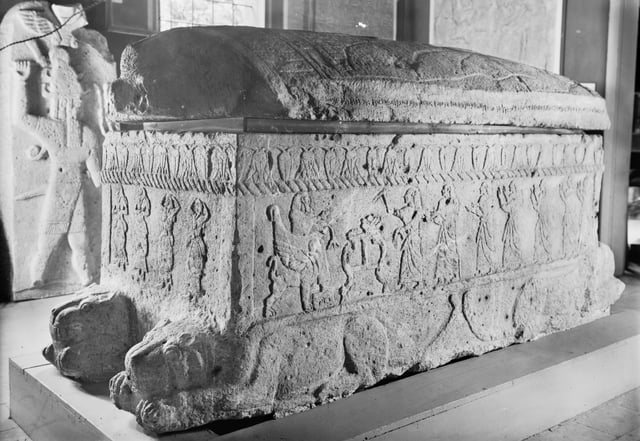
Sarcophagus of Ahiram in the National Museum of Beirut
The Phoenician alphabet was one of the first (consonantal) alphabets with a strict and consistent form.
It is assumed that it adopted its simplified linear characters from an as-yet unattested early pictorial Semitic alphabet developed some centuries earlier in the southern Levant.[60][73] It is likely that the precursor to the Phoenician alphabet was of Egyptian origin, since Middle Bronze Age alphabets from the southern Levant resemble Egyptian hieroglyphs or an early alphabetic writing system found at Wadi-el-Hol in central Egypt.[74][75] In addition to being preceded by proto-Canaanite, the Phoenician alphabet was also preceded by an alphabetic script of Mesopotamian origin called Ugaritic. The development of the Phoenician alphabet from the Proto-Canaanite coincided with the rise of the Iron Age in the 11th century BC.[76]
This alphabet has been termed an abjad — that is, a script that contains no vowels — from the first four letters aleph, beth, gimel, and daleth.
The oldest known representation of the Phoenician alphabet is inscribed on the sarcophagus of King Ahiram of Byblos, dating to the 11th century BC at the latest. Phoenician inscriptions are found in Lebanon, Syria, Israel, Cyprus and other locations, as late as the early centuries of the Christian Era. The Phoenicians are credited with spreading the Phoenician alphabet throughout the Mediterranean world.[77] Phoenician traders disseminated this writing system along Aegean trade routes, to Crete and Greece. The Greeks adopted the majority of these letters but changed some of them to vowels which were significant in their language, giving rise to the first true alphabet.
The Phoenician language is classified in the Canaanite subgroup of Northwest Semitic. Its later descendant in Northwest Africa is termed Punic. In Phoenician colonies around the western Mediterranean, beginning in the 9th century BC, Phoenician evolved into Punic. Punic Phoenician was still spoken in the 5th century AD: St. Augustine, for example, grew up in Northwest Africa and was familiar with the language.
Art
Phoenician art lacks unique characteristics that might distinguish it from its contemporaries.
This is due to its being highly influenced by foreign artistic cultures: primarily Egypt, Greece and Assyria. Phoenicians who were taught on the banks of the Nile and the Euphrates gained a wide artistic experience and finally came to create their own art, which was an amalgam of foreign models and perspectives.[78] In an article from The New York Times
He entered into other men's labors and made most of his heritage.
The Sphinx of Egypt became Asiatic, and its new form was transplanted to Nineveh on the one side and to Greece on the other. The rosettes and other patterns of the Babylonian cylinders were introduced into the handiwork of Phoenicia, and so passed on to the West, while the hero of the ancient Chaldean epic became first the Tyrian Melkarth, and then the Herakles of Hellas.
Religion

Figure of Ba'al with raised arm, 14th–12th century BC, found at ancient Ugarit (Ras Shamra site), a city at the far north of the Phoenician coast. Musée du Louvre
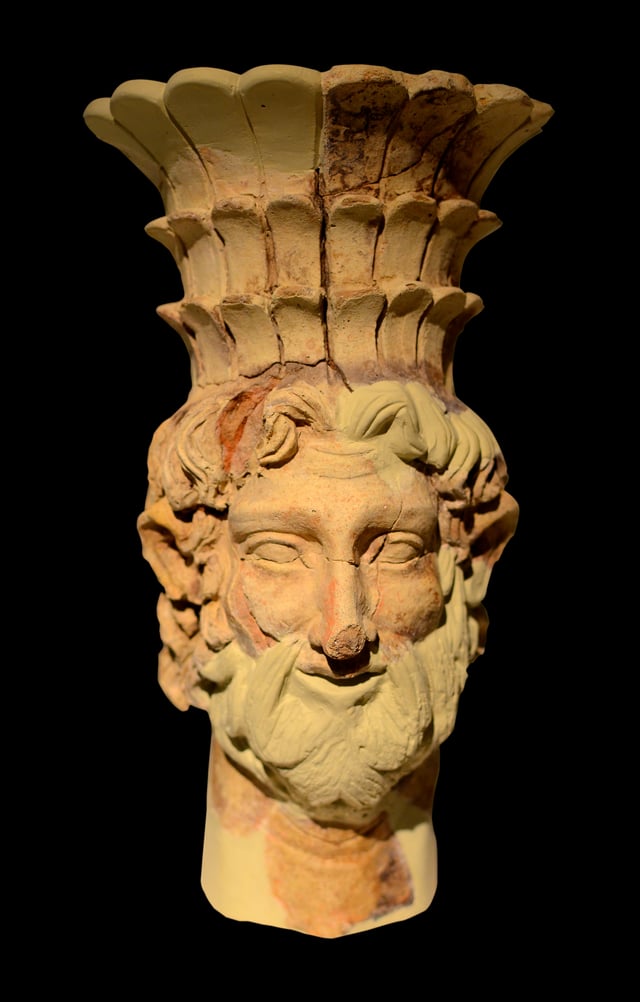
An incense burner depicting Ba'al-Hamon, 2nd century BC
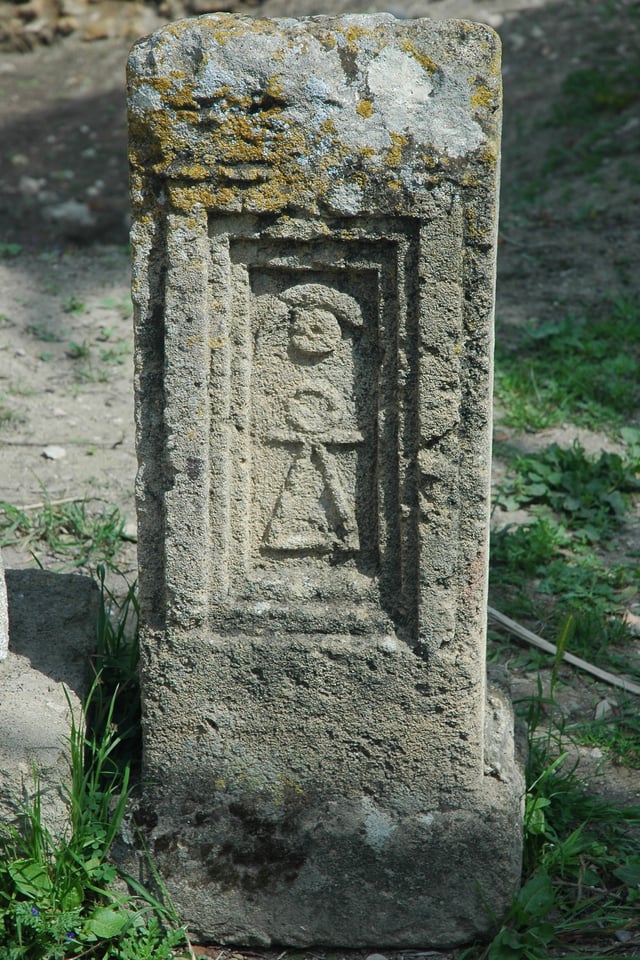
Tophet funerary stele, showing (below moon and sun) a symbol of Tanit, queen goddess of Carthage

Sign of Tanit, one of several variations.[125]
The religious practices and beliefs of Phoenicia were cognate generally to their neighbours in Canaan, which in turn shared characteristics common throughout the ancient Semitic world.[79]Ancient%20Semitic%20Civiliz]] [81] e primarily for city-state purposes; payment of taxes by citizens was considered in the category of religious sacrifices.[82] Unfortunately, many of the Phoenician sacred writings known to the ancients have been lost.[83][84]
Phoenician society was devoted to the state Canaanite religion.[85]Dictionary%20of%20Compar]] [87] on,[88] and child sacrifice.[89] "Tophets", built "to burn their sons and their daughters in the fire", are condemned by Yahweh in the Hebrew bible, particularly in Jeremiah 7:30–32, and in 2nd Kings 23:10 (also 17:17). Notwithstanding these and other important differences, cultural religious similarities between the ancient Hebrews and the Phoenicians persisted.[85][90]
Canaanite religious mythology does not appear as elaborated compared with existent literature of their cousin Semites in Mesopotamia. In Canaan the supreme god was called El (𐤀𐤋, "god").[91][92] The son of El was Baal (𐤁𐤏𐤋, "master", "lord"), a powerful dying-and-rising storm god.[93] Other gods were called by royal titles, as in Melqart meaning "king of the city",[94] or Adonis for "lord".[95] (Such epithets may often have been merely local titles for the same deities.) On the other hand, the Phoenicians, notorious for being secretive in business, might use these non-descript words as cover for the secluded name of the god,[96] known only to a select few initiated into the inmost circle, or not even used by them, much as their neighbors and close relatives the ancient Israelites/Judeans sometimes used the honorific Adonai (Heb: "My Lord") in place of the tetragrammaton—a practice which became standard (if not mandatory) in the Second Temple period onward.[97]
The Semitic pantheon was well-populated; which god became primary evidently depended on the exigencies of a particular city-state or tribal locale.[98][99] Due perhaps to the leading role of the city-state of Tyre, its reigning god Melqart was prominent throughout Phoenicia and overseas. Also of great general interest was Astarte (𐤀𐤔𐤕𐤓𐤕)—a form of the Babylonian Ishtar—a fertility goddess who also enjoyed regal and matronly aspects. The prominent deity Eshmun of Sidon was a healing god, seemingly cognate with deities such as Adonis (possibly a local variant of the same) and Attis. Associated with the fertility and harvest myth widespread in the region, in this regard Eshmun was linked with Astarte; other like pairings included Ishtar and Tammuz in Babylon, and Isis and Osiris in Egypt.[100]
Religious institutions of great antiquity in Tyre, called marzeh (𐤌𐤓𐤆𐤄, "place of reunion"), did much to foster social bonding and "kin" loyalty.[101] These institutions held banquets for their membership on festival days. Various marzeh societies developed into elite fraternities, becoming very influential in the commercial trade and governance of Tyre. As now understood, each marzeh originated in the congeniality inspired and then nurtured by a series of ritual meals, shared together as trusted "kin", all held in honor of the deified ancestors.[102] Later, at the Punic city-state of Carthage, the "citizen body was divided into groups which met at times for common feasts." Such festival groups may also have composed the voting cohort for selecting members of the city-state's Assembly.[103][104]
Religion in Carthage was based on inherited Phoenician ways of devotion. In fact, until its fall embassies from Carthage would regularly make the journey to Tyre to worship Melqart, bringing material offerings.[105][106] Transplanted to distant Carthage, these Phoenician ways persisted, but naturally acquired distinctive traits: perhaps influenced by a spiritual and cultural evolution, or synthesizing Berber tribal practices, or transforming under the stress of political and economic forces encountered by the city-state. Over time the original Phoenician exemplar developed distinctly, becoming the Punic religion at Carthage.[107] "The Carthaginians were notorious in antiquity for the intensity of their religious beliefs."[108] "Besides their reputation as merchants, the Carthaginians were known in the ancient world for their superstition and intense religiosity. They imagined themselves living in a world inhabited by supernatural powers which were mostly malevolent. For protection they carried amulets of various origins and had them buried with them when they died."[109]
At Carthage, as at Tyre, religion was integral to the city's life. A committee of ten elders selected by the civil authorities regulated worship and built the temples with public funds. Some priesthoods were hereditary to certain families. Punic inscriptions list a hierarchy of cohen (priest) and rab cohenim (lord priests). Each temple was under the supervision of its chief priest or priestess. To enter the Temple of Eshmun one had to abstain from sexual intercourse for three days, and from eating beans and pork.[110] Private citizens also nurtured their own destiny, as evidenced by the common use of theophoric personal names, e.g., Hasdrubal, "he who has Baal's help" and Hamilcar [Abdelmelqart], "pledged to the service of Melqart".[111]
The city's legendary founder, Elissa or Dido, was the widow of Acharbas the high priest of Tyre in service to its principal deity Melqart.[112] Dido was also attached to the fertility goddess Astarte. With her Dido brought not only ritual implements for the worship of Astarte, but also her priests and sacred prostitutes (taken from Cyprus).[113] The agricultural turned healing god Eshmun was worshipped at Carthage, as were other deities. Melqart became supplanted at the Punic city-state by the emergent god Baal Hammon, which perhaps means "lord of the altars of incense" (thought to be an epithet to cloak the god's real name).[107][114] Later, another newly arisen deity arose eventually to reign supreme at Carthage, a goddess of agriculture and generation who manifested a regal majesty, Tanit.[115]
The name Baal Hammon (𐤁𐤏𐤋 𐤇𐤌𐤍) has attracted scholarly interest, with most scholars viewing it as a probable derivation from the Northwest Semitic ḥammān ("brazier"), suggesting the meaning "Lord of the Brazier". This may be supported by incense burners and braziers found depicting the god. Frank Moore Cross argued for a connection to Hamōn, the Ugaritic name for Mt. Amanus, an ancient name for the Nur Mountain range.[116] Modern scholars at first associated Baal Hammon with the Egyptian god Ammon of Thebes, both the Punic and the Egyptian being gods of the sun. Both also had the ram as a symbol. The Egyptian Ammon was known to have spread by trade routes to Libyans in the vicinity of modern Tunisia, well before arrival of the Phoenicians. Yet Baal Hammon's derivation from Ammon is no longer considered the most likely, as Baal Hammon has since been traced to Syrio-Phoenician origins, confirmed by recent finds at Tyre.[117] Baal Hammon is also presented as a god of agriculture: "Baal Hammon's power over the land and its fertility rendered him of great appeal to the inhabitants of Tunisia, a land of fertile wheat- and fruit-bearing plains."[118][119]
In Semitic religion El, the father of the gods, had gradually been shorn of his power by his sons and relegated to a remote part of his heavenly home; in Carthage, on the other hand, he became, once more, the head of the pantheon, under the enigmatic title of Ba'al Hammon.— Charles-Picard & Picard (1968), p. 45
Prayers of individual Carthaginians were often addressed to Baal Hammon.
Offerings to Hammon also evidently included child sacrifice.[120][121][122] Diodorus (late 1st century BC) wrote that when Agathocles had attacked Carthage (in 310) several hundred children of leading families were sacrificed to regain the god's favour.[123] In modern times, the French novelist Gustave Flaubert's 1862 work Salammbô graphically featured this god as accepting such sacrifice.[124]
The goddess Tanit during the 5th and 4th centuries became queen goddess, supreme over the city-state of Carthage, thus outshining the former chief god and her associate, Baal-Hammon.[126][127] Tanit was represented by "palm trees weighed down with dates, ripe pomegranates ready to burst, lotus or lilies coming into flower, fish, doves, frogs...." She gave to mankind a flow of vital energies.[128][129] Tanit may be Berbero-Libyan in origin, or at least assimilated to a local deity.[130][131]
Another view, supported by recent finds, holds that Tanit originated in Phoenicia, being closely linked there to the goddess Astarte.[132][133] Tanit and Astarte: each one was both a funerary and a fertility goddess. Each was a sea goddess. As Tanit was associated with Ba'al Hammon the principal god in Punic Carthage, so Astarte was with El in Phoenicia. Yet Tanit was clearly distinguished from Astarte. Astarte's heavenly emblem was the planet Venus, Tanit's the crescent moon. Tanit was portrayed as chaste; at Carthage religious prostitution was apparently not practiced.[134][135] Yet temple prostitution played an important role in Astarte's cult at Phoenicia. Also, the Greeks and Romans did not compare Tanit to the Greek Aphrodite nor to the Roman Venus as they would Astarte. Rather the comparison of Tanit would be to Hera and to Juno, regal goddesses of marriage, or to the goddess Artemis of child-birth and the hunt.[136] Tertullian (c. 160 – c.220), the Christian theologian and native of Carthage, wrote comparing Tanit to Ceres, the Roman mother goddess of agriculture.[137]
Tanit has also been identified with three different Canaanite goddesses (all being sisters/wives of El): the above 'Astarte; the virgin war goddess 'Anat; and the mother goddess 'Elat or Asherah.[138][139][140] With her being a goddess, or symbolizing a psychic archetype, accordingly it is difficult to assign a single nature to Tanit, or clearly to represent her to consciousness.[141]
A problematic theory derived from sociology of religion proposes that as Carthage passed from being a Phoenician trading station into a wealthy and sovereign city-state, and from a monarchy anchored to Tyre into a native-born Libyphoenician oligarchy, Carthaginians began to turn away from deities associated with Phoenicia, and slowly to discover or synthesize a Punic deity, the goddess Tanit.[142] A parallel theory posits that when Carthage acquired as a source of wealth substantial agricultural lands in Africa, a local fertility goddess, Tanit, developed or evolved eventually to become supreme.[109] A basis for such theories may well be the religious reform movement that emerged and prevailed at Carthage during the years 397-360. The catalyst for such dramatic change in Punic religious practice was their recent defeat in war when led by their king Himilco (d. 396) against the Greeks of Sicily.[143]
Such transformation of religion would have been instigated by a faction of wealthy land owners at Carthage, including these reforms: overthrow of the monarchy; elevation of Tanit as queen goddess and decline of Baal Hammon; allowance of foreign cults of Greek origin into the city (Demeter and Kore); decline in child sacrifice, with most votive victims changed to small animals, and with the sacrifice not directed for state purposes but, when infrequently done, performed to solicit the deity for private, family favors. This bold historical interpretation understands the reformer's motivation as "the reaction of a wealthy and cultured upper class against the primitive and antiquated aspects of the Canaanite religion, and also a political move intended to break the power of a monarchy which ruled by divine authority." The reform's popularity was precarious at first. Later, when the city was in danger of imminent attack in 310, there would be a marked regression to child sacrifice. Yet eventually the cosmopolitan religious reform and the popular worship of Tanit together contributed to "breaking through the wall of isolation which had surrounded Carthage."[144][145][146]
"When the Romans conquered Africa, Carthaginian religion was deeply entrenched even in Libyan areas, and it retained a great deal of its character under different forms."
Tanit became Juno Caelestis, "and Caelestis was supreme at Carthage itself until the triumph of Christianity, just as Tanit had been in pre-Roman times." [130] Regarding Berber (Libyan) religious beliefs, it has also been said:
"[Berber] belief in the powers of the spirits of the ancestors was not eclipsed by the introduction of new gods—Hammon, or Tanit—but existed in parallel with them.
It is this same duality, or readiness to adopt new cultural forms while retaining the old on a more intimate level, which characterizes the [Roman era]."[147]
Such Berber ambivalence, the ability to entertain multiple mysteries concurrently, apparently characterized their religion during the Punic era also.
After the passing of Punic power, the great Berber king Masinissa (r. 202–148), who long fought and challenged Carthage, was widely venerated by later generations of Berbers as divine.[148]
Deities
Attested 1st millennium BC
Chusor
Dagon
Eshmun-Melqart
Gebory-Kon (Gebory = gabri? Kon = Chiun/Kiyun/Kaiwan/Saturn?)
Melqart
Milkashtart
Reshef-Shed
Shed-Horon
Tanit-Astarte
Attested 2nd millennium BC
Foreign relations
Influence in the Mediterranean region
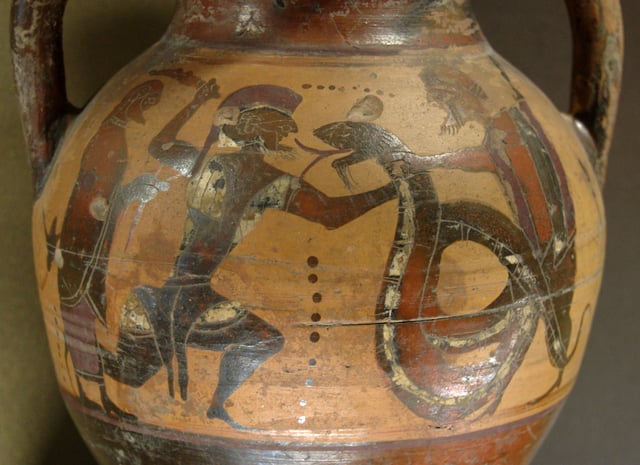
Cadmus fighting the dragon. Side A of a black-figured amphora from Eubœa, c. 560 – 550 BC, Louvre
Phoenician culture had a huge effect upon the cultures of the Mediterranean basin in the early Iron Age, and had been affected by them in turn.
For example, in Phoenicia, the tripartite division between Baal, Mot and Yam seems to have influenced the Greek division between Zeus, Hades and Poseidon.[149] The Tartessos region probably embraced the whole southern part of the Iberian Peninsula.[150] Strab. 3.2.11). In various Mediterranean ports during the classical period, Phoenician temples sacred to Melkart were recognized as sacred to Greek Hercules. Stories like the Rape of Europa, and the coming of Cadmus also draw upon Phoenician influence.
The recovery of the Mediterranean economy after the late Bronze Age collapse (c. 1200 BC) seems to have been largely due to the work of Phoenician traders and merchant princes, who re-established long distance trade between Egypt and Mesopotamia in the 10th century BC.
There are many countries and cities around the Mediterranean region that derive their names from the Phoenician language.
Below is a list with the respective meanings:
Altiburus: City in Algeria, SW of Carthage. From Phoenician: Iltabrush
Bosa: City in Sardinia: From Phoenician Bis'en
Cádiz: City in Spain: From Phoenician Gadir
Dhali (Idalion): City in Central Cyprus: From Phoenician Idyal
Erice: City in Sicily: From Phoenician Eryx
Malta: Island in the Mediterranean: From Phoenician Malat ("refuge")
Marion: City in West Cyprus: From Phoenician Aymar
Oued Dekri: City in Algeria: From Phoenician: Idiqra
Spain: From Phoenician: I-Shaphan, meaning "Land of Hyraxes". Later Latinized as Hispania
Carthage: City in Tunisia: From Phoenician Qart Hadašt meaning "New City"
Cartagena: City in Spain ((Greek: Νέα Καρχηδόνα; Latin: Carthago Nova; Spanish: Cartagena)) A colony of Carthage, which also gave rise to Cartagena, Colombia
Relations with the Greeks
Trade
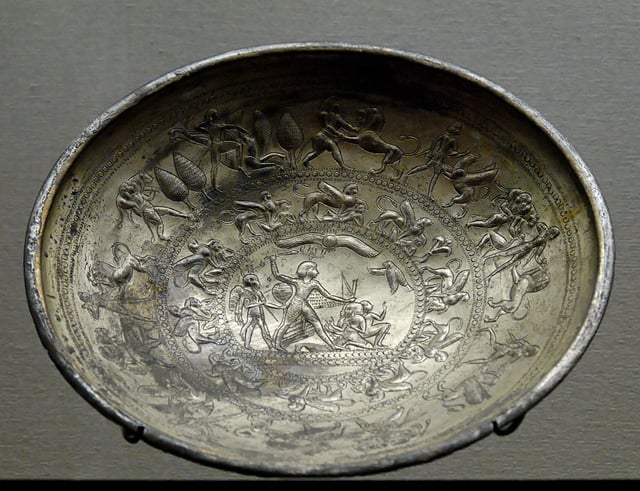
Bowl with mythological scenes, a sphinx frieze and the representation of a king vanquishing his enemies; Electrum, Cypro-Archaic I, 8th–7th centuries BC, from Idalion, Cyprus.
Towards the end of the Bronze Age (around 1200 BC) there was trade between the Canaanites (early Phoenicians), Egypt, Cyprus, and Greece.
In a shipwreck found off of the coast of Turkey (the Ulu Bulurun wreck), Canaanite storage pottery along with pottery from Cyprus and Greece was found.
The Phoenicians were famous metalworkers, and by the end of the 8th century BC, Greek city-states were sending out envoys to the Levant (the eastern Mediterranean) for metal goods.[151]
The height of Phoenician trade was circa the 7th and 8th centuries BC.
There is a dispersal of imports (ceramic, stone, and faience) from the Levant that traces a Phoenician commercial channel to the Greek mainland via the central Aegean.[151] Athens shows little evidence of this trade with few eastern imports, but other Greek coastal cities are rich with eastern imports that evidence this trade.[152]
Al Mina is a specific example of the trade that took place between the Greeks and the Phoenicians.[153] It has been theorized that by the 8th century BC, Euboean traders established a commercial enterprise with the Levantine coast and were using Al Mina (in Syria) as a base for this enterprise. There is still some question about the veracity of these claims concerning Al Mina.[152] The Phoenicians even got their name from the Greeks due to their trade. Their most famous trading product was purple dye, the Greek word for which is phoenos.[154]
Alphabet
The Phoenician phonetic alphabet was adopted and modified by the Greeks probably in the 8th century BC (around the time of the hippoi depictions). This most likely did not come from a single instance but from a culmination of commercial exchange.[154] This means that before the 8th century, there was a relationship between the Greeks and the Phoenicians. Though there is no evidence to support the suggestion, it is probable that during this period there was also a passing of religious ideas. The legendary Phoenician hero Cadmus is credited with bringing the alphabet to Greece, but it is more plausible that it was brought by Phoenician emigrants to Crete,[155] whence it gradually diffused northwards.
Connections with Greek mythology
In both Phoenician and Greek mythologies, Cadmus is a Phoenician prince, the son of Agenor, the king of Tyre in South Lebanon. Herodotus credits Cadmus for bringing the Phoenician alphabet to Greece[156] approximately sixteen hundred years before Herodotus' time, or around 2000 BC,[157] as he attested:
These Phoenicians who came with Cadmus and of whom the Gephyraeans were a part brought with them to Hellas, among many other kinds of learning, the alphabet, which had been unknown before this, I think, to the Greeks.
As time went on the sound and the form of the letters were changed.— Herodotus, The Histories, V.58 [182]
Due to the number of deities similar to the "Lord of the Sea" in classical mythology, there have been many difficulties attributing one specific name to the sea deity or the "Poseidon–Neptune" figure of Phoenician religion.
This figure of "Poseidon-Neptune" is mentioned by authors and in various inscriptions as being very important to merchants and sailors,[158] but a singular name has yet to be found.
There are, however, names for sea gods from individual city-states.
Yamm is the god of the sea of Ugarit, an ancient city-state north to Phoenicia. Yamm and Baal, the storm god of Ugaritic myth and often associated with Zeus, have an epic battle for power over the universe. While Yamm is the god of the sea, he truly represents vast chaos.[159] Baal, on the other hand, is a representative for order. In Ugaritic myth, Baal overcomes Yamm's power. In some versions of this myth, Baal kills Yamm with a mace fashioned for him, and in others, the goddess Athtart saves Yamm and says that since defeated, he should stay in his own province. Yamm is the brother of the god of death, Mot.[160] Some scholars have identified Yamm with Poseidon, although he has also been identified with Pontus.[161]
Plato
In his Republic*]]2C%20IV%20%28435e%E2%80%93436a%29]] πανουργίασοφία[163]
In his Histories, Herodotus gives the Persian and Greek accounts of a series of kidnappings that led to the Trojan War. While docked at a trading port in Argos, the Phoenicians kidnapped a group of Greek women including King Idacus's daughter, Io. The Greeks then retaliated by kidnapping Europa, a Phoenician, and later Medea. The Greeks refused to compensate the Phoenicians for the additional abduction, a fact which Paris used a generation later to justify the abduction of Helen from Argos. The Greeks then retaliated by waging war against Troy. After Troy's fall the Persians considered the Greeks to be their enemy.[164]
Ancient sources
In the Bible
Hiram (also spelled Huran), the king of Tyre, is associated with the building of Solomon's temple.
1 Kings 5:1 says: "Hiram king of Tyre sent his servants to Solomon; for he had heard that they had anointed him king in the place of his father: for Hiram was ever a lover of David." 2 Chronicles 2:14 says: "The son of a woman of the daughters of Dan, and his father [was] a man of Tyre, skillful to work in gold, silver, brass, iron, stone, timber, royal purple (from the Murex), blue, and in crimson, and fine linens; also to grave any manner of graving, and to find out every device which shall be put to him..."
This is the architect of the Temple, Hiram Abiff of Masonic lore.
Later, reforming prophets railed against the practice of drawing royal wives from among foreigners: Elijah execrated Jezebel, the princess from Tyre in South Lebanon who became a consort of King Ahab and introduced the worship of her god Baal.
Long after Phoenician culture flourished, or Phoenicia existed as a political entity, Hellenized natives of the region where Canaanites still lived were referred to as "Syro-Phoenicians", as in the Gospel of Mark
The word Bible itself derives from Greek biblion, which means "book" and either derives from, or is the (perhaps ultimately Egyptian) origin of Byblos, the Greek name of the Phoenician city Gebal.[165]
Legacy
The legacies of the Phoenicians include:
The spread of the alphabet throughout the Mediterranean extended literacy beyond a narrow caste of hierarchical priests.
They re-opened the trade routes in the Eastern Mediterranean that connected the Egyptian and Mesopotamian civilizations after the long hiatus of the Bronze Age collapse recovered, beginning the "Orientalising" trend later seen in Greek art.
They invented a more democratic and flatter oligarchic social structure than any people prior to the Athenian revolution, and in this were an inspiration to Greek constitutional government.
They pioneered the development of multi-tiered oared shipping throughout the Mediterranean region, being the first people exploring beyond the Straits of Gibraltar.
They were the first Eastern Mediterranean people to colonise the Western Mediterranean in any significant way (The Shardana may have preceded them in Sardinia), opening up urban development and trade in this region.
Greeks, Etruscans, and Romans freely admitted what they owed to the Phoenicians, and Phoenician influence can be traced in the Iberian and Celtic worlds from the 8th century BC onwards.
It is possible that Zeno of Citium, the founder of Stoicism, was of Phoenician heritage. Diogenes Laërtius writes that Crates once chastised Zeno, crying out, "Why run away, my little Phoenician?"[166]
See also
Maronites
Names of the Levant
Phoenicianism
Punic language
Punics
Tarout Island
Theory of Phoenician discovery of the Americas
Israelites